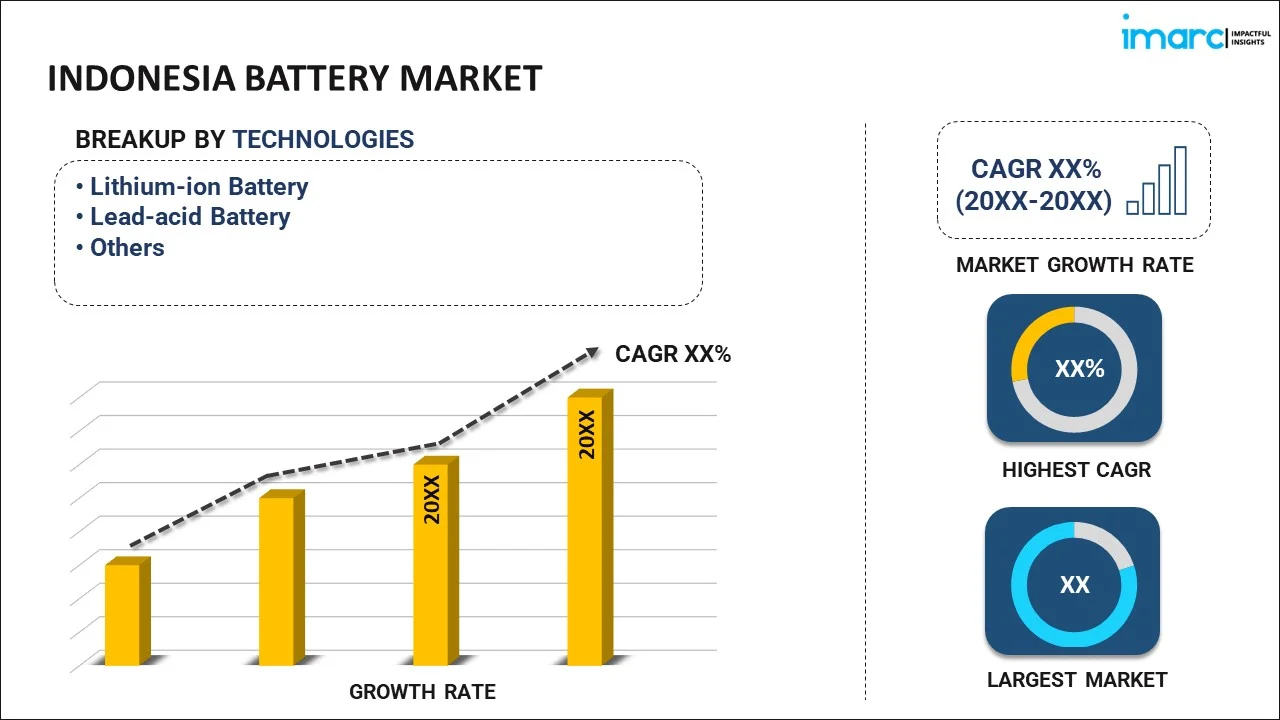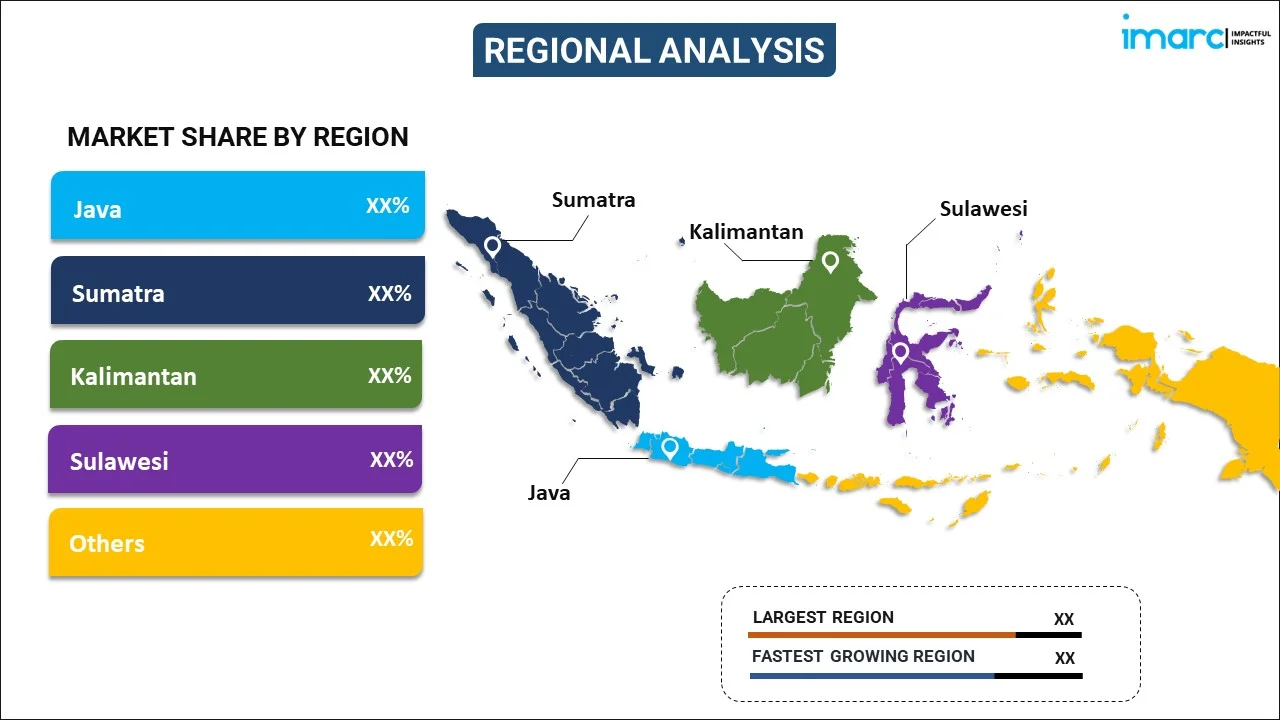
Indonesia Battery Market Report by Technology (Lithium-ion Battery, Lead-acid Battery, and Others), Application (SLI Batteries, Industrial Batteries, Portable Batteries, Automotive Batteries (HEV, PHEV, and EV), and Others), and Region 2025-2033
Market Overview:
The Indonesia battery market size reached USD 1.5 Billion in 2024. Looking forward, IMARC Group expects the market to reach USD 4.3 Billion by 2033, exhibiting a growth rate (CAGR) of 11.6% during 2025-2033. The rapid adoption of electric vehicles (EVs), the implementation of various government policies, integration of renewable energy systems, widespread demand for efficient energy storage, rising focus on infrastructure development, and the emergence of solid-state batteries and energy management systems represent some of the key factors driving the market.
|
Report Attribute
|
Key Statistics
|
|---|---|
|
Base Year
|
2024
|
|
Forecast Years
|
2025-2033
|
|
Historical Years
|
2019-2024
|
|
Market Size in 2024
|
USD 1.5 Billion |
|
Market Forecast in 2033
|
USD 4.3 Billion |
| Market Growth Rate 2025-2033 | 11.6% |
A battery refers to a device that stores electrical energy in a chemical form and converts it back into electrical power when needed. It consists of one or more cells, each containing positive and negative electrodes and an electrolyte. Batteries are available in various types, such as alkaline, lithium-ion, lead-acid, and nickel-metal hydride. They are manufactured using zinc, lithium, lead, sulfuric acid, and nickel, depending on the type and application. Batteries are utilized in automobiles, smartphones, renewable energy systems, medical devices, household appliances, remote controls, and emergency backup systems. They are also employed in industrial machinery, military applications, aerospace, and marine vessels. Batteries offer numerous benefits, such as portability, energy efficiency, scalability, reduced greenhouse gas emissions, and lower operational costs. Moreover, they provide instant power supply, rechargeability, reliability, long shelf life, and minimal maintenance requirements.
Indonesia Battery Market Trends:
Rising Demand for Electric Vehicles (EVs)
The growing demand for electric vehicles (EVs) in Indonesia is significantly boosting the need for batteries, particularly lithium-ion types. As the country moves toward cleaner transportation solutions, both government policies and consumer preferences are shifting in favor of electric mobility. Incentives such as tax breaks, subsidies, and infrastructure development for EV charging stations are encouraging more adoption. For instance, in March 2024, Indonesia's Ministry of Finance introduced tax incentives for electric vehicles, including a luxury tax removal for 2024 and import tax waivers until 2025. The target is to produce 600,000 EVs by 2030 and achieve 140GWh of battery capacity. According to Indonesia battery market analysis, the market is expected to witness accelerated growth due to these incentives, with increasing domestic production capabilities and investments in battery manufacturing. Additionally, rising environmental awareness and the global push to reduce carbon emissions are further driving the EV market growth. Lithium-ion batteries, known for their efficiency and high energy density, are becoming the preferred choice to power electric vehicles, fueling overall market growth.
Rise in Renewable Energy Storage
Renewable energy storage in Indonesia is becoming increasingly vital as the country expands its solar and wind power infrastructure. Efficient energy storage systems, particularly battery solutions, play a crucial role in capturing surplus energy generated from renewable sources. This stored energy can be used during peak demand or when renewable generation is low, ensuring grid stability and continuous power supply. For instance, in March 2024, Sembcorp Industries launched its first utility-scale solar and energy storage project in Indonesia through a joint venture with PLN Nusantara Renewables. The project, located in Nusantara, will feature 50 MW of solar power and 14 MWh of storage, generating 93 GWh of green energy yearly and reducing carbon emissions significantly. Large-scale battery systems are essential for mitigating intermittency issues associated with solar and wind energy, supporting Indonesia’s goal of integrating more renewable energy into its national grid and enhancing overall energy resilience. Collectively, these factors are significantly increasing the Indonesia battery market share, with more industries and infrastructure relying on efficient battery solutions to meet energy needs and sustainability goals. The ongoing investments in renewable energy storage and battery manufacturing are creating favorable conditions for long-term market expansion.
Growth in Domestic Battery Manufacturing
The development of domestic battery manufacturing in Indonesia is gaining momentum due to the country's vast nickel reserves, a key component in battery production. The Indonesian government is actively promoting investments in battery manufacturing facilities to position itself as a major player in the global battery supply chain. For instance, in June 2024, the Indonesian Ministry of Energy and Mineral Resources inaugurated an electric vehicle battery factory in Tangerang. The factory, operated by PT TDL Energy Indonesia, aims to boost electric motorcycle conversions and achieve net-zero emissions. It is the first in the country to reach a 20% domestic component level, with plans for further increases. By leveraging its abundant raw materials, Indonesia aims to reduce reliance on imports, foster local job creation, and become a leader in the electric vehicle (EV) and energy storage markets. This initiative supports the growing demand for batteries in both domestic and international markets, strengthening Indonesia's industrial base. According to Indonesia battery market forecast, the market is expected to experience substantial growth, driven by these factors, along with the country’s push to become a leading player in EV battery manufacturing due to its abundant nickel reserves.
Indonesia Battery Market Segmentation:
IMARC Group provides an analysis of the key trends in each segment of the market, along with forecasts at the country level for 2025-2033. Our report has categorized the market based on technology and application.
Technology Insights:

- Lithium-ion Battery
- Lead-acid Battery
- Others
The report has provided a detailed breakup and analysis of the market based on the technology. This includes lithium-ion battery, lead-acid battery, and others.
Application Insights:
- SLI Batteries
- Industrial Batteries (Motive, Stationary (Telecom, UPS, Energy Storage Systems (ESS), etc.)
- Portable Batteries (Consumer Electronics, etc.)
- Automotive Batteries (HEV, PHEV, and EV)
- Others
A detailed breakup and analysis of the market based on the application have also been provided in the report. This includes SLI batteries, industrial batteries (motive, stationary (telecom, UPS, energy storage systems (ESS), etc.), portable batteries (consumer electronics, etc.), automotive batteries (HEV, PHEV, and EV), and others.
Regional Insights:

- Java
- Sumatra
- Kalimantan
- Sulawesi
- Others
The report has also provided a comprehensive analysis of all the major regional markets, which include Java, Sumatra, Kalimantan, Sulawesi, and others.
Competitive Landscape:
The market research report has also provided a comprehensive analysis of the competitive landscape in the market. Competitive analysis such as market structure, key player positioning, top winning strategies, competitive dashboard, and company evaluation quadrant has been covered in the report. Also, detailed profiles of all major companies have been provided. Some of the key players include:
- Energizer Holdings, Inc.
- Furukawa Battery Indonesia (The Furukawa Battery Co., Ltd)
- PT. Century Batteries Indonesia
- PT. Indonesian Motobatt
- PT. New Indobatt Energy Nusantara
- PT. Yuasa Industrial Battery Indonesia
(Please note that this is only a partial list of the key players, and the complete list is provided in the report.)
Indonesia Battery Market News:
- In August 2024, the Indonesian government inaugurated a China-built anode plant for EV batteries, funded by BTR New Material Group and Stellar Investment. With an initial investment of $478 million, the plant aims to produce 80,000 metric tons annually, enhancing Indonesia's burgeoning electric vehicle industry and attracting further investment.
- In October 2024, Indonesia Battery Corporation and CATL subsidiary CBL announced a joint venture to build a battery cell manufacturing plant in Karawang, West Java, with an investment of up to $1.18 billion. Production is set to start in 2027, targeting both domestic and global market demands.
- In July 2024, Indonesia launched its first electric vehicle battery plant in Karawang, a joint venture between Hyundai Motor Group and LG Energy Solution. Capable of producing 10 GWh annually, this facility aims to position Indonesia as a key player in the global EV supply chain, leveraging its vast nickel reserves and creating new economic opportunities in Southeast Asia's largest automotive market.
Indonesia Battery Market Report Coverage:
| Report Features | Details |
|---|---|
| Base Year of the Analysis | 2024 |
| Historical Period | 2019-2024 |
| Forecast Period | 2025-2033 |
| Units | Billion USD |
| Scope of the Report | Exploration of Historical Trends and Market Outlook, Industry Catalysts and Challenges, Segment-Wise Historical and Future Market Assessment:
|
| Technologies Covered | Lithium-ion Battery, Lead-acid Battery, Others |
| Applications Covered | SLI Batteries, Industrial Batteries (Motive, Stationary (Telecom, UPS, Energy Storage Systems (ESS), etc.), Portable Batteries (Consumer Electronics, etc.), Automotive Batteries (HEV, PHEV, and EV), Others |
| Regions Covered | Java, Sumatra, Kalimantan, Sulawesi, Others |
| Companies Covered | Energizer Holdings, Inc., Furukawa Battery Indonesia (The Furukawa Battery Co., Ltd), PT. Century Batteries Indonesia, PT. Indonesian Motobatt, PT. New Indobatt Energy Nusantara, PT. Yuasa Industrial Battery Indonesia, etc. |
| Customization Scope | 10% Free Customization |
| Post-Sale Analyst Support | 10-12 Weeks |
| Delivery Format | PDF and Excel through Email (We can also provide the editable version of the report in PPT/Word format on special request) |
Key Questions Answered in This Report:
- How has the Indonesia battery market performed so far and how will it perform in the coming years?
- What has been the impact of COVID-19 on the Indonesia battery market?
- What is the breakup of the Indonesia battery market on the basis of technology?
- What is the breakup of the Indonesia battery market on the basis of application?
- What are the various stages in the value chain of the Indonesia battery market?
- What are the key driving factors and challenges in the Indonesia battery?
- What is the structure of the Indonesia battery market and who are the key players?
- What is the degree of competition in the Indonesia battery market?
Key Benefits for Stakeholders:
- IMARC’s industry report offers a comprehensive quantitative analysis of various market segments, historical and current market trends, market forecasts, and dynamics of the Indonesia battery market from 2019-2033.
- The research report provides the latest information on the market drivers, challenges, and opportunities in the Indonesia battery market.
- Porter's five forces analysis assist stakeholders in assessing the impact of new entrants, competitive rivalry, supplier power, buyer power, and the threat of substitution. It helps stakeholders to analyze the level of competition within the Indonesia battery industry and its attractiveness.
- Competitive landscape allows stakeholders to understand their competitive environment and provides an insight into the current positions of key players in the market.
Need more help?
- Speak to our experienced analysts for insights on the current market scenarios.
- Include additional segments and countries to customize the report as per your requirement.
- Gain an unparalleled competitive advantage in your domain by understanding how to utilize the report and positively impacting your operations and revenue.
- For further assistance, please connect with our analysts.
 Inquire Before Buying
Inquire Before Buying
 Speak to an Analyst
Speak to an Analyst
 Request Brochure
Request Brochure
 Request Customization
Request Customization




.webp)




.webp)












